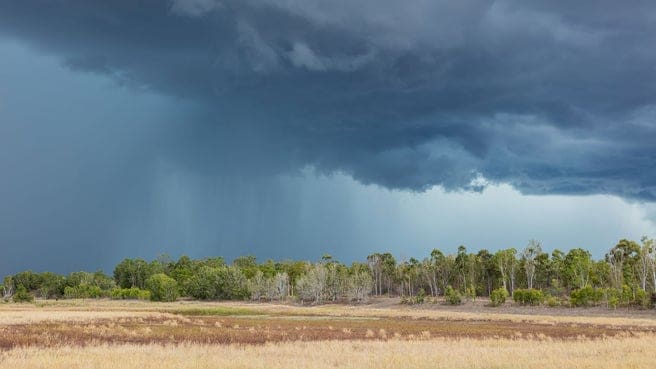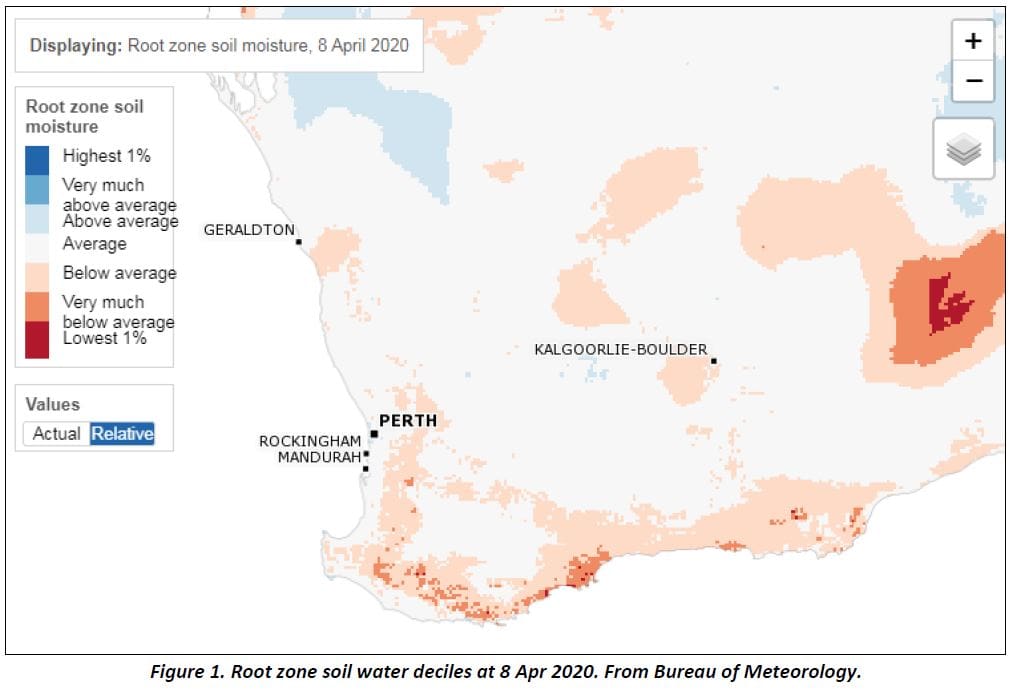
RAIN throughout February and March across much of the grain growing regions of the Western Australia, except for the northern and western areas, has produced useful levels of sub-soil moisture for the 2020 cropping programs.
The rain also resulted in decent winter weed germinations in the central and southern regions which will take the pressure off pre-emergent herbicides when the bulk of the crop is sown.
In this month’s Grain Industry Association of WA (GIWA) crop report, GIWA Oilseeds Council chair and crop review author, Michael Lamond, said the majority of the wheatbelt had reasonable early rains.

Michael Lamond
He said the falls were moreso in the central and eastern areas rather than the west and south coast, and largely missed north of Geraldton.
Mr Lamond said despite a COVID-19-induced rush for skilled people and chemical and fertiliser over the past weeks, for the moment the current supply of inputs to agriculture, including labour, did not look to be limiting production.
“With the labour force, a lot of growers can’t now get their Irish and Kiwi backpackers, but they have kids home from boarding school and university, and there are a lot of locals who have come back. So, most growers easily have enough labour, although less experienced labour. So, what a lot of growers are doing is start up a bit of dry sowing and going slowly,” he said.
“But, what is noticeable this year is that there isn’t the amount of dry sowing going on and there probably won’t be. A lot of growers, particularly north of the Great Eastern Highway, are going to be a lot more conservative with dry sowing this year and will wait to make sure there is more rain coming.”
Mr Lamond said if there was rain in the next couple of weeks there would be a big swing back into canola.
“The area sown to canola could see a swing of up to 200,000 hectares in the central regions of the state if good rains fall between now and the first week in May. The lupin area is unlikely to change to any great extent, and the oaten hay and oat areas may increase slightly,” he said.
Mr Lamond said wheat would be the dominant crop in 2020.
“Even though the increase in barley area will continue this year in the southern areas of the state, the wheat area is likely to be up in the north and eastern regions of WA,” he said.
“Wheat plantings will definitely be up because the wheat price is strong and there is a question mark around barley.
“As you go further north, because they had a tough year, they are not going to take the risk on break crops, so will just be going wheat.”
Zone by Zone
Geraldton Zone
The rainfall events in the region last month resulted in a range of sub-soil moisture levels from good in the east and southern regions, to little or none in the north. Areas that did receive 40-50mm plus are dry sowing selected “safe” paddocks to canola and lupins. The dryer areas to the north are mostly holding off at the moment to see if the next few weeks bring enough rain to risk planting canola. The traditional lupin areas on the lighter sandplain in the western parts of the region have had less effective rainfall and growers are sitting on the fence before committing to large areas.
For growers in the eastern and southern areas of the zone that are sowing dry, most are in no rush and are just doing daylight hours. Many growers were unable to secure their usual seasonal labour and their requirements have been met by locals coming back to the region, and family members coming back home from school or university. Whilst it can make for interesting family dynamics, many have commented that the enforced COVID-19 home time together “is a nice change of pace”, and the pressures of long hours over seeding will be less.
The current predictions on crop areas for the Geraldton zone are wheat increasing, barley down, with canola and lupins potentially large swings depending on the timing and amount of rainfall in the next four weeks. The strong wheat price and the ability to forward sell, combined with the need to “make up ground” on the poor production and financial results of 2019 will likely see a jump in wheat plantings. Barley north of Mingenew will definitely drop back, due to the fresh thoughts of the poor result from last year fresh and the ability of wheat to out-yield barley as you move into the warmer growing season further north.
Growers have seed for a significant increase in canola and lupin plantings if there are good rain falls up until the first week in May. If it remains dry, plantings will be similar to 2019.
Of concern, recent herbicide resistance tests are showing increasing levels of resistance in ryegrass and radish to the major groups of herbicides. Whilst this has driven crop species mixes and rotations for a long time, some levels of resistance are getting to critical levels where they are now limiting production options for growers. The area of Roundup Ready (RR) canola will remain at levels greater than 75 per cent of the plantings in the Geraldton zone due to the challenge of controlling ryegrass, and to a lesser extent radish, in Triazine Tolerant (TT) canola. In contrast, in the southern regions of the state hybrid Triazene Tolerant (TT) canola is planted to more hectares than Roundup Ready (RR) varieties.
Kwinana Zone
Kwinana North Midlands
The rain in February has resulted in good reserves of sub-soil moisture in most areas away from the coast, although the ‘stripey’ nature of the storm events has resulted in quite variable levels of soil moisture across regions.
The rain has resulted in good germinations of winter weeds in all areas south of the Kwinana North Midlands region and has given growers a good chance to get rid of germinated ryegrass, barley grass, radish and capeweed. Little brome grass germinated so this will need tackling later in the growing season. As often happens, the brilliant germinations of sub-clover pasture have unfortunately fizzed out, whilst paddocks that were sown to the deeper rooted legume species have survived to date. There was a good germination of volunteer cereals from these rains and this will give more flexibility in cereal rotation decisions at seeding time.
The rain has allowed growers to start the season with soil amelioration activities such as deep-ripping and spading which were put on hold last year.
The crop area mixture this year in the Kwinana North Midlands region will not change much from 2019. Wheat will replace barley due to the strong price of wheat vs barley, canola will drop back slightly unless there is good rainfall in the next few weeks, and lupins will be up slightly. As there has been in recent years, whilst there will continue to be the creep in increased oat area for hay by the dedicated hay growers, there is not likely to be any significant change in oat area for grain.
The eastern areas of the zone will be predominantly wheat and the area into crop will likely increase from 2019 due to the fallow areas from 2019 planted to crop. There will still be areas of fallow for rotational purposes even though in the past these areas would have been cropped with the amount of sub-soil moisture they have this year. The area of fallow versus crop could swing quite a lot depending on the timing of the opening rains.
Kwinana South
The eastern areas of the zone received very good rains over the summer with the amount dropping off pretty quickly in western areas. The western areas where there is more legume pasture had good germinations of sub-clover which has all died now from the recent hot days with not enough moisture to keep them going.
Winter weed germinations were very good across the zone and these were sprayed out straight away to conserve soil moisture. Getting a germination of winter weeds out of the way will also take the pressure off pre-emergent herbicides when it comes to sowing the bulk of the crop.
There is likely to be little change in the percentage of wheat versus barley as even though the wheat price is good, barley has the potential to out-yield wheat in the western areas of the zone where most of the barley is grown.
Canola areas will be up in the western areas, back to where it was two to three years ago and whist it is a bit too early to make a call on the eastern areas, if good rain falls in the next four weeks the area could go up quite substantially.
The lupin area is likely to remain similar to 2019, or if there is early rain then slightly decrease substituted by canola. The oat area is unlikely to change much from 2019.
Kwinana North East
The low rainfall regions of the zone have generally received good falls of rain and have useful levels of stored moisture for the 2020 growing season.
Wheat plantings dominate the region and due to the lower than average production out of the region and profit in 2020, most growers will be taking a pretty conservative approach to the year and not change programs significantly.
The far eastern and northern areas have had good rainfall over summer and if these areas get a reasonable rainfall event in the next 4-6 weeks large areas of crop will go in.
Albany Zone
Albany West
Small areas of long season canola and long season wheats were sown into moisture and are now up, although most crops being sown now are going in dry. The early rain gave growers the opportunity to sow pasture mixtures and those that did have some nice stands of pasture coming up at the moment.
Most of the canola sowing will start after Easter, with oats and barley following soon behind.
Crop area changes from last year are going to be just small “tweaks” at this stage with the recent trend continuing of barley up at the expense of wheat. Barley grain yields in the region in 2019 were on average 1.5T/HA higher than wheat, in a dryish year that should have suited wheat. And even with wheat prices strong and some question around new season barley prices, growers are opting for yield. The barley area in the rotation for growers in the region is starting to push up to its limits and whilst growers understand the risks with barley leaf disease, most think it can be managed at the moment.
The oat area to grain is not likely to change significantly from 2019 as the price/yield differential with barley still suggests barley is the better option. There will be a slight increase in the area of oats for hay from the dedicated hay growers, as there has been in recent years.
The canola area may increase slightly from 2019, although many growers are up around 30 per cent or more in the rotation and increases above that affect the balance in the rotation. The area of RR canola will increase, taking over to some extent from TT varieties due to the difficulty in controlling ryegrass. The price-spread between GM and non-GM canola is currently historically high, driven by supply and demand imbalances between Canada and the EU. The spread has in the past fallen away closer to harvest and in areas such as here where the hybrid types of canola have very high top end yield potential, growers are selecting varieties on yield more than current price differentials.
Albany South
There has been very little crop planted to date other than small areas of pasture and cereals for sheep feed. The drop off in sheep numbers in the last two years may result in an increase in total crop area of between 5-10 per cent depending on the timing of the break to the season. Most growers are still carting water for stock and domestic use. The summer rain was variable across the region and for most growers, unless they were under storm clouds, they received little runoff.
The crop area mix will not change much from 2019 at this stage. There will probably be a small increase in canola back to the levels of a few years ago whilst the dominant cereal crop, barley, will remain similar to last year. Growers may swap a paddock or two to wheat from barley due to the current strong price of wheat and this may lead to measurable changes in crop area mix in some regions of the zone.
It is still a little early to comment on the likely crop area mix in the zone and as in the rest of the grainbelt, the next few weeks will determine the outcome.
Albany East (Lakes Region)
Most of the region has had 50-100mm of summer rain which has got everyone pretty excited as this has not occurred for several years. The areas with more rainfall have had a good germination of winter weeds and pasture that is surviving and hopefully will make it through to the general break of the season. The areas with less than 50mm of summer rain have lost most of the pasture that germinated and will still need good winter rainfall to achieve average yields.
Small areas of oats for hay have gone in around eastern areas of the region and vetch has gone in in the southern regions just to get the bugs out of seeding systems. Small areas of canola are being dry sown and this will back-off if there is no rain on the short-term horizon. Most growers will not fully crank up seeding operations until after Easter. Worryingly, the summer rainfall was not enough to alleviate surface water for livestock and other domestic water supplies, so most growers across the region are really hoping for some good runoff this winter to fill dams.
Barley areas will continue to increase again this year and some growers in the region will not plant wheat for the first time. Some growers have opted out of sheep altogether for the first time as well, due to the dry years and the profitability of sheep versus cropping in this region.
The oat area may increase again this year, although we think the increase will just be “noise” as the area is still very small in proportion to the total area in crop in the region. The canola area was only 60 per cent in 2019 of what it was five years ago, and this is unlikely to change unless there is good early rain.
Lupins have been performing well in a late start and growers will mostly retain current areas planted as in previous years.
Esperance Zone
There has been a fair chunk of vetch and sheep feed going in around the region and planting of beans started last week, canola will start after Easter. Some small areas of long season wheat have been planted and have germinated. East of town there is really good sub-soil moisture, whilst to the west and north not so much. When growers get going after Easter it will be all dry sowing and most will continue through until it rains.
The only significant changes to crop area may be in canola in the northern areas where it was dropped last year due to the late start. The shift from open pollenated (OP) canola to hybrid canola will continue due to the blackleg pressure and ability of the hybrids to now out yield the OPs. The barley area will be similar and wheat down a little if the increased area of canola eventuates.
Of note, there have been some mice problems in some areas which hasn’t been seen for a while.
Season Outlook
The WA Department of Primary Industries and Regional Development’s Ian Foster said rain for January to March 2020 had been near average or wetter for most of the state.
“Rainfall for the first week of April has been minimal other than for the Kimberley region. Root zone soil water at the end of the first week of April is near average for most cropping areas, and below average for the South Coast. This reflects summer rain distribution, though the warm and dry conditions in early April have dried the soil,” he said.
Seasonal rainfall outlooks from the Bureau of Meteorology and other models have mostly neutral or wetter rainfall probabilities for southern WA for April to June.
This outlook is better than the same period in 2019. The outlook for April alone indicates above normal rain is likely.
However, given the early part of the month has been dry and warm, this implies the second half of the month would have to receive significant rain to fulfil the monthly outlook:
- For the three months April to June, wetter than average conditions are likely for most of Australia. May to July is also likely to be wetter than average for much of western, central and southern Australia (mostly 60-75pc chance).
- April to June days are likely to be warmer than average across northern and eastern Australia, but cooler across much of the southern mainland.
- Nights for April to June are very likely to be warmer than average nationwide.
- The El Niño–Southern Oscillation (ENSO) and the Indian Ocean Dipole (IOD) are currently neutral and are forecast to remain neutral into winter, but the tropical ocean to the west of Australia is forecast to remain warmer than average and is likely to be the major influence on our climate over the coming season.

Source: GIWA
Grain Central: Get our free daily cropping news straight to your inbox – Click here

HAVE YOUR SAY